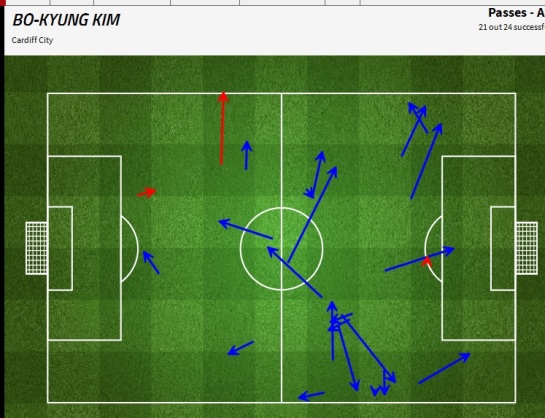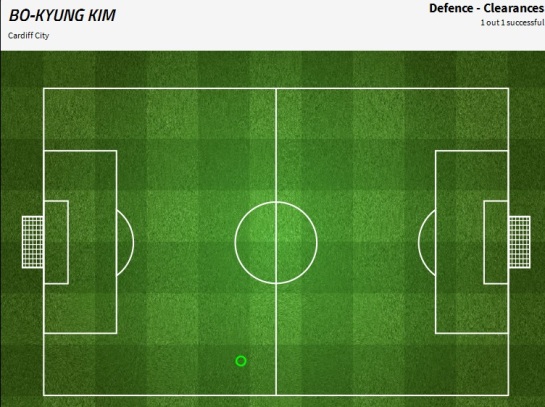Whittingham and Kim – Cardiff’s creative hub
Creativity has been hard to come by for Cardiff so far this season. It is early days, but the three matches so far have consisted of two eventually fruitful backs against the walls performances and one match where Cardiff were allowed the ball but not allowed to do much with it (the defeat to West Ham). As it’s a quiet international week, I thought I would use the downtime to take a closer look at the two players whom have had the ball in the opposition half more than anyone else in the Cardiff squad so far and whom Cardiff will (sooner rather than later, hopefully) rely on to create chances – Peter Whittingham and Kim Bo-Kyung.
Whittingham is Cardiff’s longest serving regular player, starting his seventh season with the club. After a slow start to find his feet, he came into his own during 2009-10 when 20 goals from midfield (plus another two in the playoffs) left him top of the Championship’s scoring chart (ahead of a list of players that have since proved themselves in the Premier League – Adam, Carroll, Nolan and Sigurdsson). The following three seasons brought another 30 league goals and his eventual winning over of the fans – a number had been critical of his laziness, but there can be no doubt that his workrate during matches improved exponentially over the seasons following his goal glut. In this time, he became without question Cardiff’s most important player but the opposition were learning something that West Ham put into devastating effect in the 2012 playoffs – stop Whittingham and you stop Cardiff. West Ham knocked Cardiff out 5-0 on aggregate.
During 2012-13, Whittingham started playing increasingly deeper in attempts to get hold of the ball away from the interest of his marker, all of which severely compromised his ability to create. By dropping back, the opposition could mark up all of Whittingham’s attacking passing options and often leave him with little choice but to move the ball wide to a fullback. His individual performance quality dropped despite the team climbing to the top of the table, and, following a 2-1 defeat to relegation threatened Peterborough, manager Malky Mackay did something unheard of for a few seasons…Peter Whittingham was dropped to the bench.
The fall of Whittingham coincided neatly with the rise of Kim. The South Korean international arrived at Cardiff shortly before winning a London 2012 bronze medal and was used sparingly by Mackay, despite putting in some increasingly confident performances. As he adjusted to the division, Kim’s skilful feet and close control led him to become something that is quite a rarity in any division- a player who can clearly be seen as a class above the opposition and his teammates. However, it was April before Mackay finally saw enough to give Kim a regular run of starts. Forming an impressive midfield trio with Gunnarson and Mutch, Kim played a big part in carrying Cardiff over the line to promotion at the head of the midfield triangle. There seems little reason to think that Whittingham himself could not have filled this role, and it has never been established whether Whittingham dropped deep under manager instructions or his own instinct to find the ball. Whatever the case, it was Kim who had now become the Cardiff player most likely to scare the opposition.
Now, Mackay is attempting to use the two midfielders in the same lineup and faces the challenge of getting the most out of both. This may not be as difficult to do as it looked like being in the Championship – to put the two in what are probably unfair nutshells, Whittingham is a passer and Kim is a runner. Accordingly, Whittingham has been positioned further back than Kim, not unexpected given the way they both played last season, but in a different role. Instead of being the quarterback (to use an ugly phrase coming into vogue), Whittingham has been a defensive minded left sided midfielder. Although an average position map would show the two pretty much along the halfway line, the graphics below are more telling as they show from where the two players made clearances vs Everton. Whittingham’s job was quite clearly more defensive.
Despite playing from deep, Whittingham has so far been the most likely player to create a chance. He has seven open play chances to his name so far from all over the pitch; one deep from the right, two from the centre, two from the left flank and one inside the area. West Ham has turned out to be his most creative game (over half coming in that match alone), despite Cardiff looking so toothless in attack. This is because West Ham were happy to allow Cardiff and Whittingham have the ball, having taken an early lead themselves. They could then simply keep players in their own half to limit the damage, which turned out to be minimal. Whittingham created chances but none were clear cut, except the chance created in the area (this was surprisingly missed by Maynard but was from a scuffed Whittingham shot anyway).
Whittingham’s only assist this season came from a corner and, while Kim also is without an assist, the equalising goal against Man City came from the South Korean’s darting run down the right, with a smart pullback reaching Campbell (his shot was saved into the path of goalscorer Gunnarsson). A similar run on the left flank against Everton at the start of the second half culminated in a pullback that this time ran behind the two incoming Cardiff forwards. I would expect Kim to increase these bursts as the season goes on, but perhaps not too much – his awareness of teammates and opposition on the pitch is excellent and he appears to only try things when he is sure of success. He is perhaps not as flamboyant and unpredictable as it seems; a pass success rate of 86% to Whittingham’s 79% suggests that he cautiously picks the safest route and this is perhaps borne out by the shorter nature of his passes vs Everton compared to Whittingham’s (below).


Set piece delivery is, of course, part of Whittingham’s expertise. His accurate corners to the far post caused many Championship defences problems – indeed, he troubled Howard in the Everton match by nearly swinging one straight in. In contrast, Kim often found it difficult to beat the first man when trusted with corners last season. Perhaps this is why Kim is yet to take a corner this season, with Cowie and Bellamy being the preferred right foot options so far. If there is one certainty, it is that Whittingham’s dangerous corners will continue to be a major goal threat.
Whittingham’s future role in the team would appear to depend on how Cardiff attack matches over the rest of the season. The emphasis has so far been on avoiding defeat, and it may continue that way over the next few fixtures at least. But this is unlikely to be successful enough in the long run and Cardiff won’t always be able to rely on space being available to threaten teams on the break with a Whittingham deep pass. After all, there are a number of clubs in the bottom half of the table who will be happy to take a draw at the Cardiff City Stadium (though worryingly few such sides in the opening months of the season). When these teams do arrive, Cardiff will probably need to employ a more cutting presence on the left side than Whittingham currently gives. Perhaps a swap with Kim might work, with Kim taking a more attacking role on the right and Whittingham dropping back a little from where Kim has been positioned in the centre. More worrying is the thought that Whittingham may find himself again playing the quarterback.
For now, Mackay seems likely to stick with the team that has won some unexpected points. The importance of the two creative players is going to be critical in converting draws to wins.


Thanks much, awesome article !
Thanks for reading and for your kind comment!
I very much your in depth features on City. They are most informative.
In short, City have played with four in midfield this season but tweaked the system depending on whether playing home or away. In the only away game, the opening day defeat at WHU, City played a 4-1-4-1 system with Medel playing between the back four and midfield four. For City’s two home games, picking up four points from the excellent displays against Man City and Everton, Medel joined in to the midfield four whilst Kim was pushed further foward, playing just behind lone-striker Campbell. This 4-4-1-1 for Cardiff City Stadium, offered more going forward.
For Hull (a) I would again expect City to start with Medel withdrawn in the compact 4-1-4-1 and Kim in the four across the middle of the pitch.
SP.
Thanks for the comment, Steve. Yes, I think you’re right – the big difference for the West Ham away game and the home matches was that Medel and Gunnarsson played more as a partnership.
Gunnarsson found it very hard to get involved in the WH match so hopefully Cardiff can find a way of letting those two work together in a way that also enables Kim to get forward and support Campbell.